
Louis Comfort Tiffany was an American artist and designer who worked in the decorative arts and is best known for his work in stained glass. He is the American artist most associated with the Art Nouveau and Aesthetic movements. He was affiliated with a prestigious collaborative of designers known as the Associated Artists, which included Lockwood de Forest, Candace Wheeler, and Samuel Colman. Tiffany designed stained glass windows and lamps, glass mosaics, blown glass, ceramics, jewellery, enamels, and metalwork. He was the first design director at his family company, Tiffany & Co., founded by his father Charles Lewis Tiffany.

Stained glass is coloured glass as a material or works created from it. Throughout its thousand-year history, the term has been applied almost exclusively to the windows of churches and other significant religious buildings. Although traditionally made in flat panels and used as windows, the creations of modern stained glass artists also include three-dimensional structures and sculpture. Modern vernacular usage has often extended the term "stained glass" to include domestic lead light and objets d'art created from foil glasswork exemplified in the famous lamps of Louis Comfort Tiffany.

John La Farge was an American artist whose career spanned illustration, murals, interior design, painting, and popular books on his Asian travels and other art-related topics. La Farge made stained glass windows, mainly for churches on the American east coast, beginning with a large commission for Henry Hobson Richardson's Trinity Church in Boston in 1878, and continuing for thirty years. La Farge designed stained glass as an artist, as a specialist in color, and as a technical innovator, holding a patent granted in 1880 for superimposing panes of glass. That patent would be key in his dispute with contemporary and rival Louis Comfort Tiffany.
Kog is a village in Slovenia.

Favrile glass is a type of iridescent art glass developed by Louis Comfort Tiffany. He patented this process in 1894 and first produced the glass for manufacture in 1896 in Queens, New York. It differs from most iridescent glasses because the color is ingrained in the glass itself, as well as having distinctive coloring. Tiffany won a grand prize at the 1900 Paris Exposition for his Favrile glass.
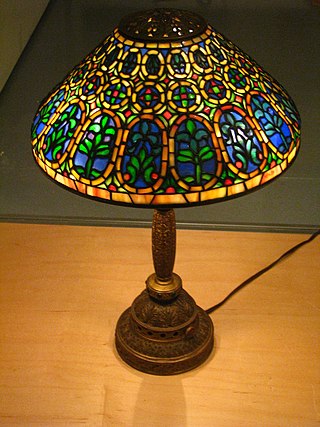
A Tiffany lamp is a type of lamp with a camed glass shade designed by Louis Comfort Tiffany or colleagues, and made in his design studio. The glass in the lampshades is put together with the copper-foil technique instead of leaded, the classic technique for stained-glass windows. Tiffany lamps are considered part of the Art Nouveau movement. Considerable numbers of designs were produced from 1893 onwards.

The Arlington Street Church is a Unitarian Universalist church across from the Public Garden in Boston, Massachusetts. Because of its geographic prominence and the notable ministers who have served the congregation, the church is considered to be among the most historically important in American Unitarianism and Unitarian Universalism. Completed in 1861, it was designed by Arthur Gilman and Gridley James Fox Bryant to resemble James Gibbs' St. Martin-in-the-Fields in London. The main sanctuary space has 16 large-scale stained-glass windows installed by Tiffany Studios from 1899 to 1930.

Blenko Glass Company, located in Milton, West Virginia, makes hand-blown glass.
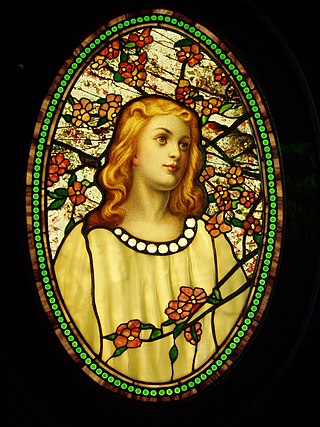
Tiffany glass refers to the many and varied types of glass developed and produced from 1878 to 1933 at the Tiffany Studios in New York City, by Louis Comfort Tiffany and a team of other designers, including Clara Driscoll, Agnes F. Northrop, and Frederick Wilson.
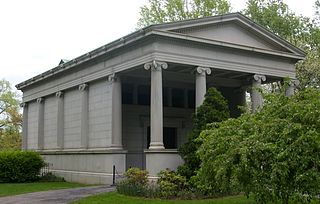
Wade Memorial Chapel is a Neoclassical chapel and receiving vault located at Lake View Cemetery in Cleveland, Ohio, in the United States. It was donated to the cemetery by Jeptha Wade II in memory of his grandfather, cemetery and Western Union co-founder Jeptha Wade. The overall design was by the newly-founded Cleveland area architectural firm of Hubbell & Benes, and was their first commission. The interior's overall design is by Louis Comfort Tiffany based on a preexisting 1893 design. The interior features two mosaics on the right and left hand walls, and a large stained glass window.

Brown Memorial Park Avenue Presbyterian Church of Baltimore, Maryland, U.S., is a large, Gothic Revival-style church built in 1870 and located at Park Avenue and Lafayette Avenue in the city's Bolton Hill neighborhood. Named in memory of a 19th-century Baltimore financier, the ornate church is noted for its exquisite stained glass windows by renowned artist Louis Comfort Tiffany, soaring vaulted ceiling, and the prominent persons associated with its history. Maltbie Babcock, who was the church's pastor 1887–1900, wrote the familiar hymn, This is My Father's World. Storied virtuoso concert performer Virgil Fox was organist at Brown Memorial early in his career (1936–1946).

William Willet was an American portrait painter, muralist, stained glass designer, studio owner and writer. An early proponent of the Gothic Revival and active in the "Early School" of American stained glass, he founded the Willet Stained Glass and Decorating Company, a stained glass studio, with his wife Anne Lee Willet, in protest against the opalescent pictorial windows which were the rage at the turn of the twentieth century.
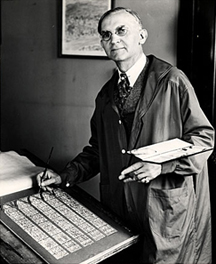
Charles Jay Connick (1875–1945) was a prominent American painter, muralist, and designer best known for his work in stained glass in the Gothic Revival style. Born in Springboro, Pennsylvania, Connick eventually settled in the Boston area where he opened his studio in 1913. Connick's work is contained in many preeminent churches and chapels, including examples in Boston, Chicago, Detroit, New York City, Pittsburgh, San Francisco, Seattle, and Washington, D.C. He also authored the book Adventures in Light and Color in 1937. Connick's studio continued to operate, and remained a leading producer of stained glass, until 1986.
Daniel Cottier (1838–1891) was a British artist and designer born in Anderston, Glasgow, Scotland. His work was said to be influenced by the writing of John Ruskin, the paintings of the Dante Gabriel Rossetti and the work of William Morris. He painted allegorical figures in the Pre-Raphaelite style of Rossetti and Sir Edward Burne-Jones. Cottier is considered to be an important influence on Louis Comfort Tiffany and also is credited with introducing the Aesthetic movement to America and Australia.
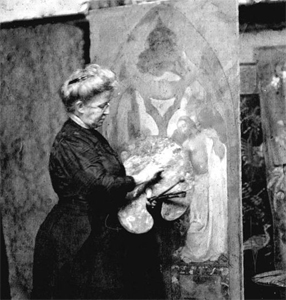
Clara Minter Parrish was an American artist from Alabama. Although she produced a large amount of work in a wide array of media, she is best known for her paintings and stained glass window designs. She was inducted into the Alabama Women's Hall of Fame in 1983.

Angel of the Resurrection is a massive stained glass window by the American Art Nouveau glass manufacturer Tiffany Studios, now in the collection of the Indianapolis Museum of Art (IMA). It was commissioned by former-First Lady Mary Dimmick Harrison as a memorial to her husband, President Benjamin Harrison. Completed in 1904, the window depicts the Archangel Michael calling for the dead to rise at the Second Coming.

The Trinity Episcopal Church, Staunton VA. is a Gothic Revival style building in Staunton, Virginia. It is an active Episcopal church in the Diocese of Southwestern Virginia. It was listed on the National Register of Historic Places (NRHP) in 1972. It is located in the Newtown Historic District.

Frederick Wilson was a British stained glass artist best known for his work with Tiffany Studios. He was a prominent designer of ecclesiastical windows in the United States during the late 19th and early 20th centuries.

Art Nouveau glass is fine glass in the Art Nouveau style. Typically the forms are undulating, sinuous and colorful art, usually inspired by natural forms. Pieces are generally larger than drinking glasses, and decorative rather than practical, other than for use as vases and lighting fittings; there is little tableware. Prominently makers, from the 1890s onwards, are in France René Lalique, Emile Gallé and the Daum brothers, the American Louis Comfort Tiffany, Christopher Dresser in Scotland and England, and Friedrich Zitzman, Karl Koepping and Max Ritter von Spaun in Germany. Art Nouveau glass included decorative objects, vases, lamps, and stained glass windows. It was usually made by hand, and was usually colored with metal oxides while in a molten state in a furnace.

Benjamin Sellers (1860–1930) was a stained glass artisan in the Northeastern US. He was a practitioner of the opalescent style of stained glass popularized by John La Farge and Louis Comfort Tiffany in the late 19th century.

















